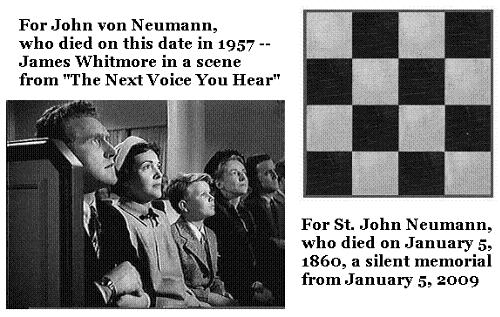The title is that of a classic 1968 New Yorker essay
by George Steiner. See previous posts on this topic.
Saturday, June 27, 2015
A Death of Kings
Tuesday, May 26, 2020
Introduction to Cyberspace
Or approaching.
On the Threshold:
Click the search result above for the July 1982 Omni
story that introduced into fiction the term "cyberspace."
Part of a page from the original Omni version —
For some other kinds of space, see my notes from the 1980's.
Some related remarks on space (and illustrated clams) —

— George Steiner, "A Death of Kings," The New Yorker ,
September 7, 1968, pp. 130 ff. The above is from p. 133.
See also Steiner on space, algebra, and Galois.
Friday, October 10, 2014
Autistic Enchantment
(Continued from Sept. 3, 2009)

George Steiner on chess:
"At the sight of a set, even the tawdriest of plastic pocket sets,
one’s fingers arch and a coldness as in a light sleep steals over
one’s spine. Not for gain, not for knowledge or reknown, but
in some autistic enchantment, pure as one of Bach’s inverted
canons or Euler’s formula for polyhedra."
— George Steiner in “A Death of Kings,” The New Yorker,
issue dated September 7, 1968, page 133
A related remark from Dudeney:

See also a different context for 16 squares and 322,560 arrangements.
Thursday, September 3, 2009
Thursday September 3, 2009
“Music and mathematics are among the pre-eminent wonders of the race. Levi-Strauss sees in the invention of melody ‘a key to the supreme mystery’ of man– a clue, could we but follow it, to the singular structure and genius of the species. The power of mathematics to devise actions for reasons as subtle, witty, manifold as any offered by sensory experience and to move forward in an endless unfolding of self-creating life is one of the strange, deep marks man leaves on the world. Chess, on the other hand, is a game in which thirty-two bits of ivory, horn, wood, metal, or (in stalags) sawdust stuck together with shoe polish, are pushed around on sixty-four alternately coloured squares. To the addict, such a description is blasphemy. The origins of chess are shrouded in mists of controversy, but unquestionably this very ancient, trivial pastime has seemed to many exceptionally intelligent human beings of many races and centuries to constitute a reality, a focus for the emotions, as substantial as, often more substantial than, reality itself. Cards can come to mean the same absolute. But their magnetism is impure. A mania for whist or poker hooks into the obvious, universal magic of money. The financial element in chess, where it exists at all, has always been small or accidental.
To a true chess player, the pushing about of thirty-two counters on 8×8 squares is an end in itself, a whole world next to which that of a mere biological or political or social life seems messy, stale, and contingent. Even the patzer, the wretched amateur who charges out with his knight pawn when the opponent’s bishop decamps to R4, feels this daemonic spell. There are siren moments when quite normal creatures otherwise engaged, men such as Lenin and myself, feel like giving up everything– marriage, mortgages, careers, the Russian Revolution– in order to spend their days and nights moving little carved objects up and down a quadrate board. At the sight of a set, even the tawdriest of plastic pocket sets, one’s fingers arch and a coldness as in a light sleep steals over one’s spine. Not for gain, not for knowledge or reknown, but in some autistic enchantment, pure as one of Bach’s inverted canons or Euler’s formula for polyhedra.”
— George Steiner in “A Death of Kings,” The New Yorker, issue dated September 7, 1968, page 133
“Examples are the stained-glass windows of knowledge.” —Nabokov

Click above images for some context.
Log24 entries of May 30, 2006, as well as “For John Cramer’s daughter Kathryn”– August 27, 2009— and related material at Wikipedia (where Kathryn is known as “Pleasantville”).
Saturday, April 4, 2009
Saturday April 4, 2009
"… in some autistic enchantment, pure as one of Bach's inverted canons or Euler's formula for polyhedra."
pure as one of Bach's inverted canons or Euler's formula for polyhedra."
— George Steiner, "A Death of Kings," in The New Yorker, issue dated Sept. 7, 1968
A correspondence underlying
the Steiner system S(5,8,24)–

The Steiner here is
Jakob, not George.
 See "Pope to Pray on
See "Pope to Pray on
Autism Sunday 2009."
See also Log24 on that
Sunday– February 8:

Tuesday, March 10, 2009
Tuesday March 10, 2009
“Music, mathematics, and chess are in vital respects dynamic acts of location. Symbolic counters are arranged in significant rows. Solutions, be they of a discord, of an algebraic equation, or of a positional impasse, are achieved by a regrouping, by a sequential reordering of individual units and unit-clusters (notes, integers, rooks or pawns). The child-master, like his adult counterpart, is able to visualize in an instantaneous yet preternaturally confident way how the thing should look several moves hence. He sees the logical, the necessary harmonic and melodic argument as it arises out of an initial key relation or the preliminary fragments of a theme. He knows the order, the appropriate dimension, of the sum or geometric figure before he has performed the intervening steps. He announces mate in six because the victorious end position, the maximally efficient configuration of his pieces on the board, lies somehow ‘out there’ in graphic, inexplicably clear sight of his mind….”
“… in some autistic enchantment, pure as one of Bach’s inverted canons or Euler’s formula for polyhedra.”
— George Steiner, “A Death of Kings,” in The New Yorker, issue dated Sept. 7, 1968
“Classrooms are filled with discussions not of the Bible and Jesus but of 10 ‘core values’– perseverance and curiosity, for instance– that are woven into the curriculum.”
— “Secular Education, Catholic Values,” by Javier C. Hernandez, The New York Times, Sunday, March 8, 2009
— Raymond Chandler, The Big Sleep
The Chandler quotation appears in “Language Game,” an entry in this journal on April 7, 2008.
Some say the “Language Game” date, April 7, is the true date (fixed, permanent) of the Crucifixion– by analogy, Eliot’s “still point” and Jung’s “centre.” (See yesterday, noon.)
Monday, March 9, 2009
Monday March 9, 2009
Next Sunday's New York Times Book Review arrived in today's mail. On the inside of the first page is a full-page ad for a course of 24 lectures on DVD's called "Games People Play: Game Theory in Life, Business, and Beyond." On the inside of the last page is "Our Steiner Problem– and Mine," a full-page essay by Lee Siegel on polymath George Steiner.
Related material:
- The five Log24 entries ending Jan. 19, 2008
- "The End of Endings," by Richard John Neuhaus
Happy birthday to the late Bobby Fischer.
And tell sad stories of the death of kings"
— Richard II, Act III, Scene ii

Russell Crowe as game theorist
John Nash in "A Beautiful Mind"
Saturday, January 19, 2008
Saturday January 19, 2008
Bobby Fischer
Edward Rothstein has a piece on Bobby Fischer in today’s New York Times. The Rothstein opening:
“There may be only three human activities in which miraculous accomplishment is possible before adulthood: mathematics, music and chess.”
This echoes the opening of a classic George Steiner essay (The New Yorker, Sept. 7, 1968):
“There are three intellectual pursuits, and, so far as I am aware, only three, in which human beings have performed major feats before the age of puberty. They are music, mathematics, and chess.”
— “A Death of Kings,” reprinted in George Steiner: A Reader, Oxford University Press, 1984, pp. 171-178.
Despite its promising (if unoriginal) opening, the New York Times piece is mainly an attack on Fischer’s anti-Jewish stance. Rothstein actually has little of interest to say about what he calls the “glass-bead games” of music, mathematics, and chess. For a better-written piece on chess and madness, see Charles Krauthammer’s 2005 essay in TIME. The feuilletons of Rothstein and Krauthammer do not, of course, come close to the genuinely bead-game-like writing of Steiner.
Related material on
chess and religion:
Magical Thinking
(December 7th, 2005)



